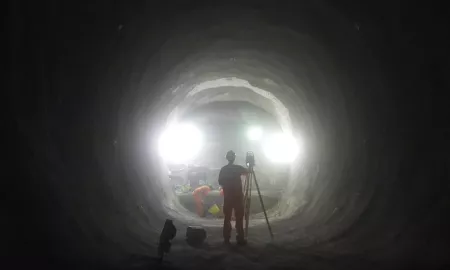One of the most frequently used geotechnical monitoring instruments, piezometers have measured pore water pressures and water levels on the majority of major construction projects, including Crossrail, the Channel Tunnel Rail Link (CTRL) and Dover Western Docks Revival (DWDR) land reclamation, to name a few. They continue to be a crucial sensor in a geotechnical engineer’s arsenal.

Dave Jones - senior project manager in our Monitoring team – covers what a piezometer is and how they are used, the different methods of installation and the benefits of each, as well as common installation pitfalls to avoid to ensure the accuracy of your data.
What is a Piezometer?
Piezometers are geotechnical sensors that measure pore water pressure and water level. They can be used to detect an increase or decrease in the pore water pressure, as well as monitoring for any seasonal change in water levels and tidal influence.
There are several different types of piezometer, used for different applications, and the three most common ones used in our Monitoring team are:
- Vibrating wire piezometers and pneumatic piezometers: these are used to measure pore water pressure
- Standpipe piezometers: can be used to measure water level
Why and when are piezometers used?
Typically, vibrating wire and pneumatic piezometers are used when reclaiming land or when constructing embankments for highways, roads and rail, bridges and dams, industrial developments etc., where you are managing a fill operation and you want to understand the behaviour of the soil when adding a mass above the original ground. A piezometer, in this case, will measure how this loading will impact the water pressure in the ground. It is crucial to measure this as, if the water pressure increases as you add load, it can lead to hydraulic fracturing and create slip planes, where a region of pressure increase jacks up the ground above and separates it from the ground below. This is a cause of slip failures.
For example, when you add 1 metre of load, you would expect the observed pressure to increase by approximately 1 metre head of water and then for it to dissipate off. Through monitoring the pore water pressure, you are looking for that dissipation to show the pressure is easing, and then the next load of fill can be added safely.
Proper evaluation of pore water pressure can aid in design improvements during construction, identifying areas which may be susceptible to fracturing so that mitigation measures can be put in place, avoiding potentially dangerous slip failures which could impact the stability of the structure.
Another common use of piezometers is for monitoring water level. This can be done using VW or pneumatic sensors, but you must ensure that the water column above the sensor is open to the atmosphere, i.e. within a well or standpipe, and not a sealed cell. If you do not have the sensor open to atmosphere you may see unrepresentative data, where the water is pressurised within the soil, leading to an elevated reading, but the actual water column is not increased. Water levels have traditionally been monitored using standpipes. These are a tube with a slotted, filtered tip installed within a borehole to the depth of the water table you want to observe. The top of the tube is left open to atmosphere, and the water level can be measured using either a manual probe or sensor, or one of many automated sensors, left in the standpipe. This could include those mentioned above as well as 4-20mA transducers and other technologies, either with on board, manually downloaded data loggers, or via wireless nodes or cabled data loggers, to online monitoring systems such as Calyx OMS™.
How are piezometers installed?
Over the years, there has been some debate regarding the most effective method of installation of vibrating wire and pneumatic piezometers.
The traditional method of installation involves drilling a hole in the ground down to the target strata, the geological level where you are looking for the change. The piezometer is lowered into the borehole and the piezometer tip is surrounded by 0.6 metres to 1 metre of sand or gravel. Above that, the borehole is sealed with 1 metre of bentonite pellets, creating an impermeable seal. It is important that the installation is properly sealed. Using this method, you can install several piezometers in the same borehole, if trying to monitor pore water pressures at different levels of strata. Each piezometer tip is simply surrounded by sand, and the gap between the piezometers sealed with bentonite pellets. The remaining void, at the top of the borehole, is commonly backfilled with cementitious bentonite grout.
More recently, however, increasing numbers of piezometers are being installed using the fully grouted method.
In simple terms, this method involves hanging the piezometer in the borehole and then filling the borehole fully with grout. The theory being that water pressures transmit horizontally through the ground.
With this method, there were initially some concerns that water pressures would transmit up and down the column of grout, rather than representing the water table local to the piezometer tip. This has not proved to be the case, however, and this is now widely accepted as a viable alternative method and is more commonly seen in specifications.
What is our Monitoring team's favoured method of installation?
At SOCOTEC Monitoring, both installation methods are used, with roughly an even split. There is increasing evidence that fully grouted is a very viable installation method, especially as it can save time and there is less chance of technical issues with the installation. With the traditional method, when pouring sand and bentonite pellets into the borehole there is a chance that these materials will bridge, meaning they create a bridge across the borehole and leave a void. A piezometer not properly surrounded and sealed is a technical disaster and would ruin an installation, so this is something to avoid. The fully grouted method is much less likely to cause this difficulty.
There are some pitfalls to avoid when installing multiple piezometers into a borehole using the fully grouted method, however, where drill casings need to be withdrawn from the borehole once the installation is made. In this scenario, the piezometers need to be supported on a tube. For example, you could have a 19mm diameter plastic tube, and you would cable tie the piezometers to that tube, at predetermined depths, before lowering them down into the borehole. This means the borehole needs to be drilled at the exact depth, as the piezometers have been attached to the tube at the exact depths requiring monitoring. It can be a challenge for drillers to achieve this level of accuracy.
Once in position, grout is either tremied or poured in around the tube. There have been concerns that the tube could be a route for water to pass up and down, which would impact the readings but, at SOCOTEC Monitoring, we have not seen much evidence of this. On some sites we have seen evidence that, near the surface at least, the grout can shrink away from the tube to leave a gap, but in our experience readings have not been affected by this.
Another important thing to note is the time it can take for new piezometer installations to settle. When you drill a borehole you effectively pull water out of the ground and it can take a while for it to recharge after the installation. With the fully grouted method this tends to be a longer process than for sand cell installations – sometimes up to a month - for the water to fully soak in and for everything to be balanced, especially if you are dealing with very firm clay, or other less porous materials. Once everything is at equilibrium, however, the piezometers respond to pressure immediately.
With both the traditional and fully grouted installation methods it is essential to keep this lag time in mind, especially if baseline readings are required, as an additional month may need to be factored into the planning to allow the piezometer installation to settle prior to starting baseline readings.
How do piezometers work?
A vibrating wire piezometer is, in simple terms, a steel tube with a fixed cap across one end and a flexible diaphragm across the other end. A steel wire (a bit like a piano wire) is tensioned between the fixed cap and the diaphragm. If you push the diaphragm, and change the pressure, the tension on the wire becomes less, and if you pull the diaphragm the tension increases. Any change in pore pressure directly affects the tension in the wire via the diaphragm. The wire is plucked by a coil magnet and the frequency of the wire’s vibration is measured – think of something like a guitar pick-up. This is how a vibrating wire piezometer measures pore water pressure. The greater the water pressure the slacker the wire is, and the lower the frequency the reading.
Piezometer readings can be either manual or automated. If manual, at the top of a borehole a terminal unit is connected, or a cable can be extended and run in a trench. An engineer can then manually plug in and take a reading. More commonly now though, piezometers are automated and connected to wireless nodes which lead to a gateway or data logger. Data can be downloaded directly from the gateway or logger and then brought into monitoring software, for example Calyx OMS™.
In situations where a manual method is chosen, it is usually a cost decision, and when a lower frequency of readings is required. An automated system results in continual readings being taken with more data generated, giving clients a better understanding of what is going on, revealing daily and seasonal variations rather than just giving snapshots. Additional benefits of automated monitoring include fewer boots on site and less lone worker site visits, improving health and safety for employees, and reducing carbon footprints.
Notable projects piezometers have been used on:
Here are just a few of the projects our Monitoring team has used piezometers on:
- A4440 Worcester Southern Link Road widening works
- Phase 1 of the Perth Transport Futures Project
- A19 / A1058 Coast Road Junction Improvement Scheme
- Bexhill to Hastings Relief Road
- A66 Surtees Bridge
- Crossrail
- Dover Western Docks Revival (DWDR)
If you have a geotechnical monitoring project you would like to discuss, please get in touch.
Want to find out more about our geotechnical monitoring services?

You might also like







Add new comment